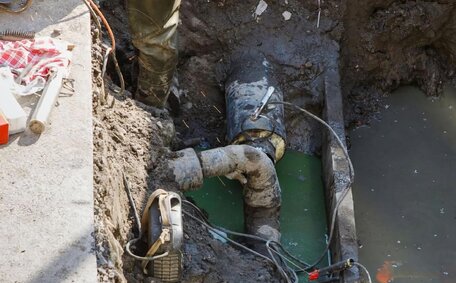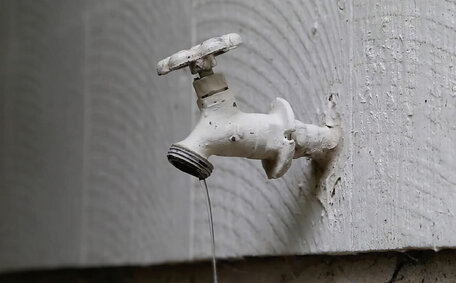What is Pipe Relining and How Does it Work?
Sewer pipe relining is an innovative repair technique that installs a new pipe inside the existing one without excavation, cutting the cost of traditional pipe repair. This process involves inserting an epoxy resin liner into the old pipe, which is then expanded and hardened to form a smooth, seamless interior, remedying any broken pipe issues.
The cured epoxy liner effectively creates a new internal pipe, offering a significant benefit over full pipe replacement by keeping the existing exterior structure intact. Drain relining produces relined pipes that strengthen compromised pipes and shield them from further corrosion, cracks, leaks, and tree root infiltration. It also restores water flow and eliminates blockages, offering peace of mind and demonstrating the advantages of pipe relining without the need for complete pipe replacement.
Key benefits of pipe relining, compared to traditional pipe replacement and drain cleaning services, include:
- Less expensive
- Faster with no need to dig up or destroy your yard
- Long-term solution with a life expectancy exceeding 50 years
- Prevents future pipe problems
Whether you’re experiencing issues now or want to proactively maintain your plumbing, Pipe relining services can be used as an effective method for protecting pipes and preventing major pipe damage down the track.
Benefits of Pipe Relining as Preventative Maintenance
Pipe relining has several key advantages as a proactive measure, rather than a response to complete pipe failure:
- Extends pipe lifespan - Proactive epoxy relining coats and reinforces pipes, preventing issues that could lead to blocked drains and damage your plumbing infrastructure. This is crucial for mending damaged broken pipes and enhances longevity, with an expected service life of 50+ years.
- Avoids water damage - Relining stops small leaks before they become big bursts, minimising the risk of flooding and waterlogged walls/ceilings.
- Improves water quality - Preventing leaks prevents contaminants from infiltrating clean water supplies throughout your plumbing.
- Saves money - While pipe relining has an initial cost, it is more affordable in the long run than emergency pipe replacements and costly maintenance.
- Minimizes disruption - Pipe relining, a trench-free process, requires only small access points, avoiding the upheaval of digging up pipes.
- Comes with long warranties - Many providers offer 10, 15 or even lifetime guarantees on pipe relining work.
Prompt pipe relining prevents extensive repairs, reinforcing the adage 'a stitch in time saves nine’. Maintain your drains proactively; early identification of problems and preventive relining can fortify your pipes for the long haul.
How to Know if Your Pipes are a Good Candidate for Relining
Determining where pipe relining is applicable in your plumbing system requires a specialist assessment. However, there are a few key signs to look out for:
- Pipe material - Materials like concrete, clay, galvanised steel, and cast iron are ideal for CIPP pipe relining, while PVC and copper pipes typically do not require relining.
- Pipe size - Pipes with diameters from 50 to 300 mm are eligible for relining, ensuring optimal flow in your drains.
- Pipe condition - Relining can address recurring clogs, leaks, rust stains, or dips in your sewer line. However, severely damaged or broken pipes may require either repair or replacement.
A CCTV drain inspection is the most effective way to gauge potential pipe relining costs and understand what the procedure entails. This detailed inspection involves sending a camera through your pipe system to identify any faults such as cracks, holes, root intrusions, or collapses. Reviewing this footage helps plumbers assess the extent of damage and decide whether epoxy relining is suitable or if a full replacement is warranted, especially in cases of tree root invasion.
Contact us today to speak with a pipe relining specialist who can assess your plumbing needs and arrange a detailed sewer inspection. They’ll be able to provide same day accurate pipe relining recommendations based on the exact condition of your pipes.
Signs Your Pipes May Need Relining
There are several common signs that indicate your pipes may be in need of relining, including:
- Frequent blockages: If you’re continually dealing with a slowed or completely blocked drain, this shows buildup and corrosion inside that needs addressing.
- Discoloured water: Rusty, brownish or dirty-looking water coming from taps or toilets points to corroded pipes contaminating your water flow.
- Lower water pressure: Pressure that seems weaker than usual and problems with hot water delivery signal mineral deposits or obstructions inside the pipes.
- Strange noises: Dripping, knocking, belching or gurgling sounds indicate serious issues inside your plumbing system that require attention.
- Musty odours: Odd smells emerging from drains suggest microbial buildup or possible sewage leaks.
Addressing these early warning signs with used pipe relining is imperative to halt corrosion and decay before pipes fail completely. Left too long, the risk of repairing damaged pipes due to cracks, collapses and massive water damage increases.
At the first sign of trouble, Consult a professional about this innovative repair method, as it is beneficial for both residential and commercial properties as a preventative strategy.
Consider Relining Old Pipes Proactively
This holds particularly true for older properties with pipes nearing or exceeding their expected lifespan. In areas like Quakers Hill with many ageing properties, proactively relining pipes can prevent expensive emergency repairs down the track.
Even if you aren’t experiencing any noticeable issues, your old galvanised, concrete or clay pipes may be decaying from the inside.
The corrosion process is slow and stealthy until one day, without warning, a pipe fails catastrophically. You’re then facing waterlogged walls, flooded rooms, huge repair bills and tremendous disruption to your building or business.
Pipe relining averts these emergencies by reinforcing ageing pipes prior to critical failure. Using epoxy liners, pipe relining effectively creates a new inner pipe within aging systems, serving as a robust protective barrier. This approach guarantees extended durability for your pipes, restoring structural stability, enhancing leak protection, and significantly lengthening their functional life.
Indeed, Pipe relining may involve a higher immediate cost compared to postponing action. When compared to the substantial costs of complete pipe replacements due to failures, the upfront expenses of relining prove more cost-effective over the long term. You likewise reduce risks of water damage and avoid the substantial inconvenience associated with emergency repairs.
Talk to your plumber about your pipe relining options, especially in older properties. If deterioration is caught early, pipe relining makes an excellent proactive maintenance choice to fortify your plumbing for the decades ahead.
The Step-By-Step Pipe Relining Process
Pipe relining is a multi-step trenchless repair process that renews pipes from the inside out. The key stages include:
- Pipe Inspection: Initially, technicians use a specialised drain camera to conduct a thorough inspection of sewer pipes, pinpointing any defects or problems.
- Cleaning & Repairs: Following this, high-pressure water jetting removes debris and buildup, preparing the drain pipe for the relining process. Any joints, cracks, or breaches are effectively addressed to repair pipes.
- Felt Soaking: A felt liner sock saturated with water-activated epoxy resin is inserted into the pipe via access points like manholes.
- Liner Installation: The lining process is carried out using an inflatable bladder device known as an inversion drum, which inverts the resin-soaked liner as it propels through the pipe.
- Curing & Hardening: Demonstrating how pipe relining works, the epoxy-saturated liner adheres and hardens to the old pipe walls, resulting in a smooth, seamlessly fused "pipe-within-a-pipe”.
The advantages of state-of-the-art pipe relining services are evident as the new interior lining restores functionality and fortifies weakened pipes for enduring performance. With no digging or destruction, pipe relining offers a less invasive and efficient fix.
Long-Term Cost Savings of Proactive Relining
Being proactive about pipe relining can lead to major cost savings over time compared to emergency pipe repairs or full replacements. Studies show that on average, proactive pipe relining costs around 60% less than reactively fixing burst, corroded or blocked pipes.
Key factors that contribute to the long-term savings of a preventative pipe relining project include:
- Greatly reduced traditional drain repairs costs by avoiding massive pipe replacement projects
- Minimised damage to your property with less digging, jackhammering and destruction
- Enhanced pipe lifespan of 50+ years thanks to durable epoxy liners
- Prevention of leaks limits water wastage and contamination
- Higher flow capacity increases water pressure and performance
Although pipe relining requires an initial investment, addressing minor issues proactively prevents escalating costs in the future. Water damage alone from pipe failures can cost over $15,000 on average.
To achieve the best savings for your business, it’s prudent to have pipes regularly inspected and proactively relined upon detection of any deterioration. In the realm of plumbing, preventative measures truly outweigh the cost of extensive repairs.
Choosing a Reputable Contractor
Choosing an experienced and trustworthy pipe relining contractor is crucial. To identify reputable providers, consider the following key tips:
- Verify credentials and certifications - Ensure technicians are fully licenced, insured and specially trained in epoxy relining.
- Examine previous projects and customer feedback - Assess service quality by examining project galleries and reading client testimonials.
- Opt for locals - Opt for companies well-versed in local pipe types, soil conditions, and building codes, such as Quakers Hill Plumbing, which possesses invaluable local expertise.
- Inquire about warranty coverage - Reputable contractors, mindful of pipe relining costs, offer extensive warranties on parts and labour, typically exceeding five years.
- Get quotes - Reputable pipe lining professionals provide detailed quotes outlining exactly what’s included so there’s no additional cost surprises post-job.
Rely on professional pipe relining Sydney services from Quakers Hill Plumbing, with over 50 years of experience in the region. Contact us directly today for obligation-free advice on proactive pipe relining for your home or business needs.






